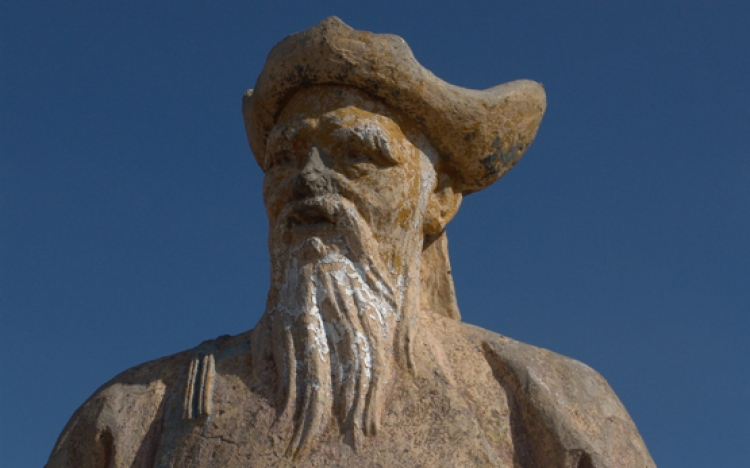


|
Buon compleanno, Gengis Khan
I segreti del grande CondottieroWhat does the Europe know about Mongolia? What have the European people and in general “ western “world preserved in their historical memory “about Mongolian people? Mongolia has remained a mystery for centuries , and even now the myths about our country are strong factors that attract the tourists from the whole world to see Mongolia and live their stay like an great adventure , almost like travelling in the time rather than visiting place itself. Mongolia is the authentic place of dreams about the past. Well, I would say about the glorious past of the Greatest Empire that has ever existed in the world in the whole history of mankind.
However, what makes the legends and myths survive and live for such a long time? Would I make a mistake if I say eternity in this case? Medieval annalists described the Mongols as half-human barbarians bent on rape and pillage, terrible apparitions with animal instincts for blood. Indeed, I would say ,those horrors of a Mongol war campaigns would be truly hard to imagine: cities razed, provinces devastated, thousands enslaved, tens of thousands butchered. Is it all true? It is said , their invasions caused fearsome destruction and led to the extinction of entire nations. For example, medieval Hungary is said to had lost nearly the half of its population.
News of the overwhelming Mongol triumph sent horror all over the European world. The terrible horsemen had appeared so suddenly , and at so many place at the same time, that Europeans started talking about a mongol “ horde”, numberless and irresistible, bringing” God’s wrath “down upon a sinful populace. The Mongols, some said, had the bodies of men but the heads of dogs, and fed on the bodies of their victims! The Mongols were believed the demon worshippers led by evil spirit! In churches throughout Europe people prayed: “ Oh, Lord, from the fury of Tartars deliver us.” They believed , only a miracle could save them from the “ hord”.
NONE of the chronicles explain the TRUE reason for Mongol successes as , actually, the history of their victories was written by their enemies. No surprise that they ( enemies) understood poorly the Mongol methods of warfare and always sought excuses for the shocking defeats of “splendid armies” by so-called barbarians. Mongol success were not acts of God, barbarous ferocity, or wonder weapons, but brilliant generalship , careful planning, strictest ever discipline , and organization. The Mongols were experts in mobile warfare, and the lessons of their campaigns are as important today as they were in 13 th century, when the Mongols were truly the masters of all they surveyed.
Lev Tolstoy, great Russian writer, once wrote that “ at the time each person who considered him/herself to belong to a social layer of “intelligentia” would learn on purpose to speak fluently the language of uyugurts”. The language of uyugurts was nothing else but the beautiful Mongolian ancient language with its sophisticated scripture that Mongolia has been reaccepting back again over the last few decades. The language of Mongols was the real true “business” language as we use English language today. There are plenty of words form Mongolian language that entered the vocabularies of many nations as their own without any suspect that once they belonged to Mongols only. Without going too far away , how many of you know that the word YOGURT is a Mongolian word?
Well, before really getting how the word YOGURT finished into the such a broad , I would say ,even commercial usage of the world of today, we should talk all over again about the formidable army of Mongol Empire .
Lets say the truth. Mongol and also Turkish horse archers raided China , Iran eastern Europe for centuries. The nomad youngsters learnt to ride and fight from their earliest infancy; they were used to hardship, hunger, harsh climate, and they grew up to be the world’s finest light cavalrymen. The conditions of steppes demanded self-reliance( by the way the concept of friendship is admirably profound even today in Mongolia despite of the dividing so called “ unwritten laws” of free market economics policy that globalizes the world of nowadays!). Only Ghenghis Khaan ( Chinghis Khaan) ‘ s disciplinary measures , methods and probably his strong but still human qualities and ,what we may call today, the “ charm “ of his leadership could convince to enter the sternest individuals into his army. Ghenghis Khaan richly rewarded valor and loyalty, the slightest disobedience or hint to cowardice were punished by death.
By the way,the important fact was the decimal organization of nomad armies : arban, jagun, myangan , tumen, ordu. Arban was formed by ten mounted archers; ten troops, a squadron of jagun; a brigade was myanghan; ten brigades formed a division of tumen. Three or more tumens with brigades of engineeres , artillery or siege machine and other support units made up a mongol field army ORDU, or what Europeans called “ HORDES”.
The main weapon was a very powerful reflex bow , its range and rate were not equal to none of weapons until the invention of magazine rifles. Just try to imagine: upwards of 400 metres and 20 shots( wow!) a MINUTE! Firepower and movement combined with ancient tactics of hunting were the main strategy methods of Mongol army.
The most efficient ever supply system where to replenish empty quivers , replace broken weapons and bring up the remounts even in the middle of the battles has been admired by scientists and researchers even today.
Now we are getting back to YOGURT! Mongolian horsemen used to travel for days? No, for weeks! For months! Covering immense distances a day , they used to bring with them some horse milk as the part of their daily ration carrying it in a special leather bag attached on the side of their horses. The soldiers, especially the couriers , run nonstop for days , with a constant and stable pass from one point to another. Together with the course of a horse the milk in the sidebags used to turn into something like what we know today : yogurt! Russians would call Mongols “ uyugurt”s , and that “ strange “ milk product the soldiers would get out of their sidebags got the name as the “ food of uyugurts”, that gradually became and transformed into our “ yogurt” , one of the healthiest milk products we all get to stay in good shape?, Well, I’d rather say, in great shape!
We can talk endlessly about Mongols and Mongolia, most mysterious and for someone “ mystic “ place on the earth. At the times, Mongol armies were unbeatable under the rule of a single Great Khaan, there were no weapons to match the reflex bow’ s performance, no soldiers to match the Mongols’ skill and discipline.
I would repeat, Mongol success was not to superior numbers, acts of God or miraculous weapons. The success was not due to ferocity of so called half-human barbarians , but brilliant leadership and one of the most intelligent systems of organization that probably has never had equals even till nowadays in the mankind’s history. Ayana Sambuu or Lady Des |




